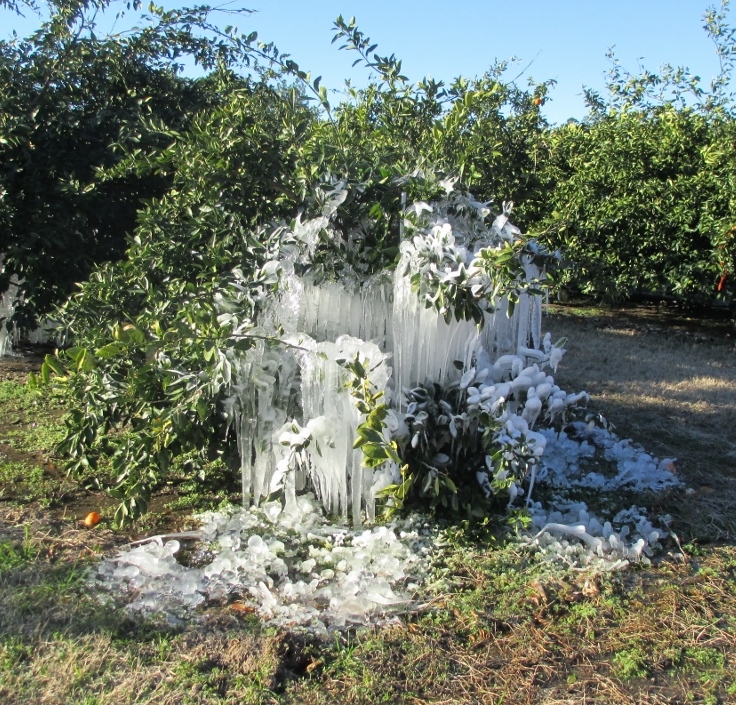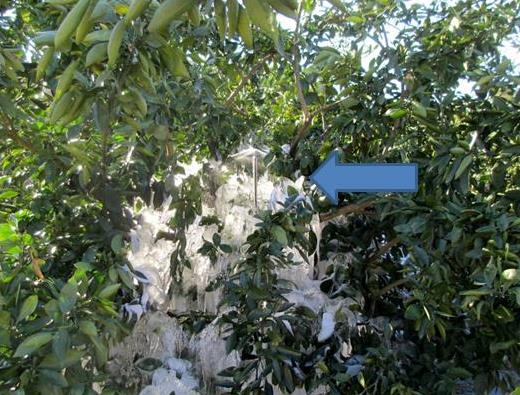
Citrus tree in Jackson County under the protection of a micro-irrigation system. Image Credit Doug Mayo
This week, Northwest Florida received some of the coldest weather in recent years, with lows ranging from 14 ºF to 20 ºF two nights in a row. This had the potential to impact local citrus production areas heavily. It is still too early to asses the full extent of the damage that this freeze event had on local citrus production, but preliminary surveys indicate that properly protected trees received minimal damage to major limbs and graft union. However, the old adage “time will tell” applies in this case since the full extent of leaf damage will not be visible until next week. If a citrus tree retains the majority of their leaves, than crop loss for the next year should be minimal. If a tree loses most of its leaves, crop loss for the next year may be expected.

Arrow points to microsprinkler irrigation emitter in action. Notice that it is positioned to protect the trunk, graft union and inner structural branches of the tree. Image Credit Doug Mayo
Microsprinkler-irrigation, the option of choice used by Panhandle Citrus producers for cold protection, has proven to be effective through several tests in central Florida. This practice can protect entire satsuma trees if the trees are short in stature. Keep in mind that the sprinklers must be running throughout the entire freeze event. They need to be turned on at 36º F and left on until the temperature reaches 42 ºF. For north Florida citrus producers using microsprinkler irrigation In last week’s freeze event this meant that water was turned on at roughly 2:00pm Monday afternoon and left on until 11:00am Wednesday morning. If the tree is too large for complete coverage, the emitter should be located on the windy side of the tree, roughly 1-2 feet away from the trunk, to be sure that the water covers the graft union. Most trees will eventually recover from freezing temperatures if the union is not damaged. Microsprinkler-irrigation, will not protect fruit, therefore, all fruit must be harvested before temperatures reach below 25 ºF
A major factor to consider when planting citrus in the Florida Panhandle includes using only cold-adapted citrus cultivars. Satsumas, or satsuma mandarins, are the most widely planted cold hardy citrus types in North Florida. Three cultivars that have been planted for many years throughout northwest Florida are Owari, Silverhill and Kimbrough, with Owari being the most popular. For cold-hardy citrus plantings to be successful, the cultivars must be grafted to a cold tolerant rootstock. Trifoliate-orange (Poncirus trifoliata) has been the rootstock of choice for imparting cold-hardiness, but sour orange (Citrus × aurantium) has been used as well for cold hardiness qualities.
Additional tips for citrus protection during extreme freeze events:
- Generally, satsuma are cold tolerant down to 15° F, but young trees, or trees yet to achieve dormancy, are usually only tolerant to 26°F. Fruit should not sustain damage from temperatures above 25°F. In fact, temperatures between 25°F and 35°F enhance the sweetness of the fruit.
- Water is a great asset, because well watered soil retains more heat, and a well watered plant has less chance of drying out during an advective freeze (freeze caused by cold air mass, with wind).
- Extreme winds sometimes make the effects of freeze events worse if the trees are not well watered. A hydrated tree is a well protected tree. On the whole, still, or windless nights (radiational freezes) make for worse freeze events since cold air will “settle” into low areas.
- Wrap the trunk with commercial tree wrap or mound soil around the base of the tree up to 2 feet. This will protect the graft of the young tree. Thus, if the branches freeze the graft union will be protected.
- For established citrus trees, mound soil around the tree in a cone formation. Do not mulch the trees over the winter since heat that radiates up from the soil will be blocked somewhat by mulch.
- Do not cover trees with plastic tarp, these will not protect the tree and can “cook” the tree once the sun comes out.
- For additional information check out this publication on micro-sprinkler irrigation.
If you have further questions contact your extension office at the Solutions for your Life website.
- Steps to Remedy Non-Productive Pecan Orchards - June 30, 2023
- If Not Disease, Then What? Abiotic Vegetable Disorders - June 24, 2022
- Dormant Sprays Protect Fruit Trees from Future Insects and Diseases - January 28, 2022
